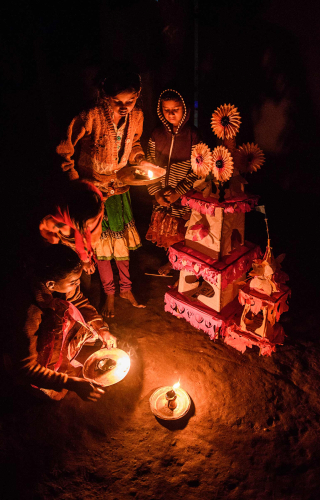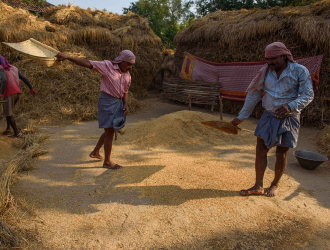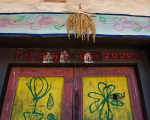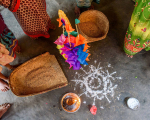“Tor pirite aachhi re raji/ tobe koris na phankibaji”
(I am ready to accept your love. But do not be half-hearted in it.)
— a Tusu song
The Chhota Nagpur plateau is a junction of three states: Odisha, Jharkhand and West Bengal. This region is home to various tribal communities such as the Kurmis, Oraons, Santhals, Mundas, Baigas and Kudumis. These communities celebrate festivals such as Tusu, Bandna and Karam, all of which are linked to the agricultural cycle. Of the three, Tusu is a rural harvest festival which is celebrated throughout the month of Poush (Bengali calendar’s ninth month, which overlaps with December and January) and ends on the day of Makar Sankranti (mid-January). As I come from Kolkata, documenting Tusu in the remote locations was a challenge for me. The town of Bagmundi (Purulia district) was my base from where I had to hire private transport to reach the various villages, haats (markets) and melas (fairground). Because it is a tribal belt, language can also be a barrier. I was lucky because the locals understood my native Bengali which they speak as a lingua franca in this region. During my field work, I was really touched by the simplicity of the local people and the way they accepted me in their homes and shared their knowledge about the festival.
There are many stories about the possible origin of the word ‘tusu’. Three legends connect Tusu festival with a girl named Tusumani. According to the first story, Tusumani was the daughter of a potter and got married to a prince, but suddenly her husband passed away. Tusumani committed Sati by jumping into her husband’s pyre on the day of Makar Sankranti. Since then, people have been celebrating Tusu festival on that day. The second story says that a king married Tusumani and she died at a young age. The king was mad with grief and to get him back to health, villagers placed an idol of Tusumani beside him. Thus, the tradition of worshipping Tusu started. In the third story, a Mughal king fell in love with Tusumani but her father did not agree to the marriage. In revenge, the king started to torture villagers, and to save them, Tusumani took her own life. For her sacrifice, she is worshipped during Tusu festival.
While I acknowledge the alternative theories about its etymology, in all probability Tusu is named after ‘tush’, which is husk of rice grain. This is more likely the source because it is an agricultural festival and the harvesting of tush is an important signifier of prosperity in the context of farming. The last stack that remains in the field after reaping the harvest is called ‘dinimai’. The head of the family brings the dinimai from the agricultural field and on the day of the festival, young girls establish Tusu. There is no idol worship involved; instead it is the fresh harvest to which thanksgiving is offered. Tusu festival lasts for a month, during which sweets are made at home and the doorstep is decorated with alpona (designs painted on walls and floors) made of rice flour mixed with water. Lamps are lit and prayers offered to Tusu, expressing gratitude for a good harvest. Prayers are also sung as folk songs and poems, accompanied by the beats of dhamsa madol (drum). Traditionally, only prepubescent girls attended Tusu daily, because they were seen as symbols of a fresh harvest. This way, the fertility of women was linked with the fertility of the land. Menstruating or married women did not take part in the rituals.
As the festival reaches its climax, colourful choudals (decorated bamboo frameworks) are sold at weekly haats. The choudal is a lightweight shrine, which is a metaphor for a vehicle. In design, they are similar to chariots (rath) pulled during the Rath Yatra. However, unlike a rath, a choudal has no wheels, nor does it have any idol placed inside. Depending on their size, choudals are either carried by hand or supported on shoulders by a team of bearers. On the day of Makar Sankranti, the Tusu is transported on a choudal by young girls and immersed in a large water body such as a river. Symbolically, the choudal is the vehicle in which the prepubescent girl leaves for her husband’s home, where the marriage is consummated and new life is ushered in. This journey and departure also signals the end of the harvest season and the completion of the agricultural cycle. Post immersion, devotees take a sacred bath in the river and prayers are offered to the sun god, Surya, because Makar Sankranti marks the first day of the sun's transit into the Makara rasi (Capricorn sun sign). Sankranti indicates the end of the month with the winter solstice and the start of longer days. Because they are used as places of mass congregation, the riverbanks are ideal as fairgrounds where traders assemble to sell a diverse range of locally made products. This way, Tusu festival plays a key role in the sustenance of rural economy and continuation of craft practices. Various forms of entertainment such as gambling, cockfighting and moron koop (well of death) are popular events at the fairs. This convergence of rural economy and agricultural rituals is what makes Tusu festival a fascinating experience.
Modernisation has had a deep impact on tribal culture and beliefs, and this change is reflected in Tusu as well. Many older rituals are no longer practised and participation is no more restricted to prepubescent girls. Nowadays, observance of month-long Tusu rituals is a rarity. Memory of Tusu poetry and songs are getting replaced by commercial song and dance routines. While earlier, Tusu was celebrated as a household affair, nowadays elaborate choudals are specially prepared for competitions, where the maker of the best shrines receives cash prize. Participation and victory in these contests are a matter of great prestige amongst choudal makers, which is why the shrines have got bigger and brighter, and attract large crowds at the melas. One of the reasons why I was interested in Tusu was its association with girls, which I as a woman photographer, wanted to understand and explore. I have been to Purulia for three consecutive years to shoot during the Tusu festival, and this includes my visit for the Frames Photography Grant. In future, I would like to expand my documentation to cover various other rituals and practices of the tribal culture of this region, many of which are linked to the agricultural cycle and veneration of nature.

















